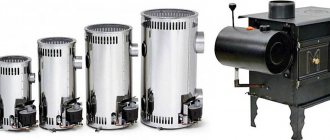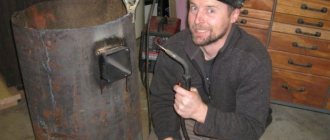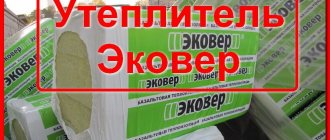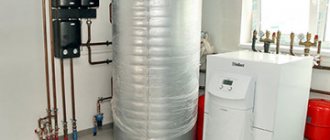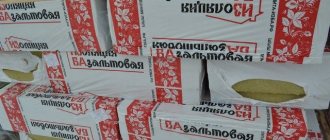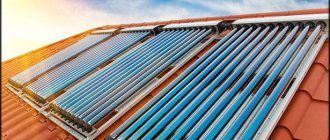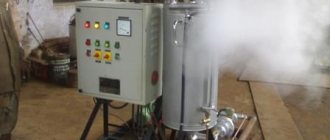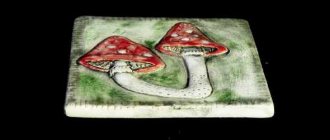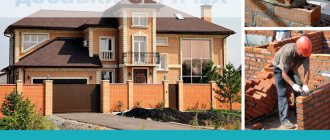This rock is obtained by firing kaolin (white clay) at high temperatures (not lower than 1000 degrees). This is done in order to increase the heat resistance of the material. During the heat treatment, impurities and liquid are completely evaporated from the clay.
In special furnaces, the rock acquires the high-strength properties of stone, which is subsequently crushed to form fireclay. It is used for the manufacture of refractory bricks, stoves, heating appliances and decorative elements.
Heat-resistant clay for bricks is, first of all, a workpiece for creating building materials by grinding and adding various substances. Fireclay has many subspecies due to the heterogeneity of raw materials and firing methods.
Advantages of refractory clay
Among the advantages of this building material the following are noted:
- Long service life. The solution does not crack, does not crumble, and retains its original shape.
- Has excellent adhesive properties. Grips well on any surface.
- Vapor permeability.
- Resistance to various temperatures.
- Clay is an environmentally friendly and completely safe product.
General information about fireclay clay
Chamotte contains high dispersion hydroaluminosilicates; this is a group of natural silicates containing silicon and aluminum. Fireclay is formed only naturally, so it is considered a natural resource.
There are marine fireclay clays and continental clays. Sea clay, as the name suggests, is mined from the seabed. Continental clays lie at the bottom of rivers and lakes. There are three largest fireclay clay deposits in Russia: Kyshtymskoye, Astafievskoye and Palevskoye. Local deposits led to the construction of factories for the production of refractory materials.
For example, the Borovichi Refractories Plant in the Novgorod Region uses fireclay clay from its own quarries.
The color of the finished fireclay clay depends on the temperature of its processing, and the color of the initial raw materials depends on organic impurities and other components. Clay without impurities has a light gray tint. There are red, yellow and even blue colors. The composition of fireclay includes the following elements:
- quartz sand;
- aluminium oxide;
- potassium oxide;
- magnesium oxide;
- calcium oxide;
- iron oxide;
- sodium oxide.
It is the resistance to high temperatures that made fireclay clay popular and in demand. In ceramic art, fireclay also has a number of advantages, including such qualities as environmental friendliness and naturalness, as well as durability.
For a ceramist, an important quality of fireclay is that it does not shrink when dried, which means there are no cracks characteristic of ordinary clay. The drying period of the product can last from 10 to 12 days. The duration of this process is affected not only by the thickness of the clay layer, but also by the humidity of the surrounding air, as well as its temperature.
White kaolin clay is formed due to the process of sedimentation of rocks. First, it is fired at a temperature of 1300-1500 degrees, as a result of which it sinteres and loses all moisture. Kaolin turns brown. Then it is crushed, and the resulting powder (chamotte) is added to the bulk to form products, as a lean additive that reduces plasticity and shrinkage. The higher the processing temperature, the more moisture the material will lose. Based on their ability to absorb moisture, finished fireclay is divided into two types:
- high-burnt;
- low-burnt.
Low-burnt fireclays have higher water absorption, that is, they are able to absorb more moisture into their pores. Water absorption is expressed as a percentage and shows the ratio of the difference in the masses of dry and wet material to the mass of dry material.
Fireclay clays can withstand temperatures up to 1800 degrees, while maintaining their properties and not collapsing. The temperature indicated is conditional. Its more accurate value depends on the concentration of fireclay and other components. Typically, manufacturers indicate the composition of the clay and provide detailed instructions for mixing. Due to the fact that ready-made bricks and fireclay clay have the same coefficient of linear expansion, it is recommended to use these materials for masonry.
A value such as humidity is also a characteristic of fireclay clay. It is necessary to understand that higher humidity causes increased plasticity of the material, and therefore increased sensitivity to temperature changes. Humidity is also indicated by the manufacturer, although this is not part of his responsibility. Clay differs in grain size. When making bricks, fine-grained fireclay is used, and in decorative arts, coarse-grained chamotte is used.
Rules for purchasing material
Before choosing refractory clay for laying stoves, you need to study the digital combination (mortar) marked on the packaging label. The higher the number, the higher the fire resistance. Other indicators may vary. The marking indicates not only the area of application, but also information about which bricks can be laid.
Particular attention must be paid to the expiration date. If it has expired, such clay should not be purchased, since kaolin loses its technological properties, which must comply with GOST 6137-8.
Composition and production
Fireclay is made from sedimentary rocks with a high concentration of aluminous substances, corundum or zircon silicates.
Kaolin is often used as a raw material - a predominantly white or light beige clay, which is a hydrated composite of aluminum and silicon oxides. The water in kaolin clay is firmly attached to the inorganic base and is removed only by high-temperature heating. Raw materials are mined in the Ural region of the country, where the largest deposits are located.
Firing of fireclay refractory clay is carried out in specially designed furnaces that create a uniform temperature of up to 1500 °C throughout the entire mass of kaolin raw materials. With intense heating, water is removed and the structure of the mineral changes. The fireclay product obtained at lower temperatures (1300 °C) is capable of absorbing up to 25% of water. Such a refractory material is called low-burning.
If heating is carried out at a maximum permissible 1500 °C, the possibility of water absorption by the product varies from 2% to 10%, which is an indicator of a high degree of firing.
Upon completion of calcination, the monolithic mass is subjected to homogenization - grinding to the stage of formation of particles with sizes from 0.2 mm to a maximum of 2.5 mm.
There is commercially available refractory clay in the form of lumps, which is used in the production of ceramics, clinker, special types of cardboard and other products with increased heat resistance.
Specifications
Among them the following are noted:
- The moisture absorption of high-firing fireclay is up to 10%, low-firing – up to 25%.
- The grain fraction must correspond to 2 mm.
- Fire resistance – up to 1850 degrees.
- Humidity – no higher than 5%.
A package of fireclay clay (20 kg) is enough to lay no more than 30 bricks. In order to produce 1 m³ of masonry, 100 kg of kaolin is required. A high-quality solution hardens within several days if the temperature is not lower than +10 degrees.
The shelf life in industrial packaging is 3 years from the date of manufacture.
Types of raw materials
Refractory material is the basis from which solutions for various purposes are made. Lump clay is used to create heat-resistant ceramics, bricks and cardboard. The ground type has high characteristics of resistance to fire and strength, which allows it to be used in coating and molding mixtures.
Fireclay is distinguished by the presence of binding additives in its composition. Based on the amount of sand, there are 3 types of raw materials:
- Exhausted. Contains up to 21% of the substance.
- Smooth. The volume of the ingredient varies between 19-48%.
- Binder. Contains 55% loose component.
For a fire-resistant surface, traditional river sand cannot be used in the solution. The substance has a maximum limit of 800 C; at high temperatures it expands, which leads to destruction. Quartz species, kaolin and cement are often used as additives.
Varieties of fireclay clay Source rusboard.net
Stone-like varieties are not used to prepare a solution from fireclay clay. According to the degree of aluminum oxide content, the substance is divided (in percentage) into:
- semi-sour (up to 25);
- basic (26-38);
- highly basic (from 40).
Fireclay powder is divided into 4 grades. Characteristics depend on the degree of fire resistance and the amount of additional ingredients. Numbering from 0 (special) to 3 affects heat resistance and the final cost of the composition.
How to prepare clay
To create a solution, you will need to take a package of powder, pour it into a working container and add water. To obtain a high-quality mixture, it should be infused for at least 3 days. Next, you need to gradually add water, stirring continuously until smooth. Some experts advise using a little sand.
When working with refractory clay for laying stoves, you need to remember that the basis for success is constant stirring. If it starts to thicken a little, you need to add a small amount of water. When obtaining a liquid consistency, you need to add powder.
To properly dilute the clay, you need to calculate the amount of water used. The finished solution will have a consistency similar to sour cream. When applied to the wall surface, the mixture should not “float” or run off. If the composition is dry, it will crumble and crumble.
When using clay for instant work, the process of preparing the mixture will be much faster, since it is not necessary to infuse the solution for 3 days.
The resulting clay must be applied with a spatula. A small tool is used to promptly pick up drips and eliminate unevenness. At the end of the work, the finished surface should dry.
Fireclay clay in ceramics
The texture of clay, its strength and aesthetics have found use as a material among designers. Fireclay is used in the production of tiles, dishes, figurines and other decorative interior elements. The master knows everything about the properties of this material, therefore he uses impurities, regulating its plasticity.
In ceramics, the most common clay is used, to which dry fireclay powder is added. The share of this powder can reach up to 50% of the total mass of the material.
Before creating a product, the master prepares a sketch from which the necessary shapes and molds are created. To prepare the solution, use the following scheme:
- The ingredients are poured into one container in a ratio of 6:4 (clay/fireclay chips).
- The resulting mixture is poured with water and infused for several days.
- By stirring, a creamy consistency is achieved.
- The solution is poured into a pre-prepared form or mold.
Some craftsmen add PVA glue to the solution to speed up hardening. Sculptures and figurines are made by applying material to a wire frame, so the clay is made more flexible. In some cases, fiberglass is added as a bonding filler. 3-4 days after completion of work, the firing stage begins. Until this point, the clay was air drying.
Finished product made of fireclay - ceramic plaque
Pre-drying is a mandatory step so that cracks do not appear on the surface during firing. Fireclay smoothly turns into ceramics at a temperature of 1300 degrees. It is important to follow the technology to ensure a high-quality and environmentally friendly product.
Instructions for use
The material is widely used in the construction industry. In addition, due to its technical properties, clay is often used for the production of step elements, since it is perfectly fixed on any surface.
Furnace laying
Many specialists in laying stoves or open fireplaces use refractory bricks during installation, which are made from a clay-fireclay mixture. When purchasing material, pay special attention to the marking: it should have the letter Ш. Since the price of such bricks is much higher, the material is used only for laying the firebox. The rest of the device is made of universal brick.
Plaster
Plastering with fireclay clay is similar to the process of working with simple plaster. To do this, use two spatulas of different sizes. Enough to finish the oven. For such work you do not need to prepare special tools.
When applying the solution, do not forget about spreading drops. They should be picked up with a spatula. When applying a layer of plaster, its thickness must be taken into account. It should not exceed 1-2 mm. Finishing work can begin only after the plaster has dried. Fireclay bricks are not wetted by water.
conclusions
Refractory clay is a natural material with many positive qualities:
- Ecological cleanliness.
- Production does not generate waste; surplus and low-quality parts are recycled for the production of less important materials.
- The materials do not emit harmful substances when heated for human health.
- Ovens made of material keep the room dry, even without heating.
- Improves the quality of other finishing materials when added to their composition.
- It is used for the manufacture of a large range of building materials and parts for various areas in industry.
- Universal material.
Why plaster the stove at all?
In what cases and why are stoves plastered? The answer to this question is no less important than the first, since, having learned it, you can understand whether this process is worth carrying out at all, or whether you can leave the stove without finishing, or decorate its walls with ceramic or fireclay tiles.
Reasons that require finishing walls with plaster include:
Properties of fireclay
All characteristics are standardized by GOST requirements, the main of which are heat-resistant abilities.
Depending on the brand, ground fire clay should and can withstand heating up to 1580 or even 1730 °C. The chemical composition is based on aluminum and silicon oxides; in addition, trace amounts of iron, calcium, magnesium, sodium, and potassium oxides are present.
If the aluminum oxide concentration reaches 40%, the refractory clay is called highly basic; when the mass fraction of this oxide is from 26% to 38%, the raw material is simply called basic. If the specific gravity of aluminum oxide does not reach 27%, the raw material is called semi-acid. The moisture content remaining in fire-resistant ground clay is usually 5%.
The material retains its properties for 3 years if storage rules are observed, including normal values of air humidity and temperature; maintaining the integrity of the original packaging. A high content of water vapor and cold in the room can lead to the loss of the declared qualities of fire-resistant products.
Scope of use
If we talk about application, fireclay clay is used as an additive to building materials, which reduces plasticity and shrinkage during drying and firing. For example, the addition of fireclay makes it possible to create sculptures whose weight exceeds two hundred and fifty kilograms.
With the help of this material, the ancient era, the art of Ancient Greece, the motifs of Japanese masters, and elements of primitive art are conveyed.
In European countries, fireclay clay is used in facing works to decorate facades, walls, and fireplaces. The industrial sector uses this material to produce refractory bricks, ceramics, various heat-resistant products, and collectible fireclay tiles.
The rough side retains perfect evenness; the effects of abrasions, unevenness and chipping are created on the front surface. The final cost of the tile depends on the severity of heterogeneity and curvilinearity.
With the help of refractory fireclay clay, the natural beauty of nature is conveyed, which is something that many people lack now. This means that products made from such material are still in demand today, in the age of fashionable European-quality renovations and perfectly smooth surfaces.
Fireproof fireclay clay
The material has become popular as a decorative finish in world architecture. Its quality has been tested by time, and we can confidently say that fireclay is reliable.

